Scotland Housing Awards 2025
Read all the shortlisted entries into this award category, excellence in development for affordable housing, at the Scotland Housing Awards (SHA) 2025 and find out who won the award on the night.
Scotland’s housing sector has continued working hard to deliver much-needed affordable housing, and this award recognises developers who have built new residential developments in any recognised affordable tenure.
This award was sponsored by West of Scotland Housing Association.
Winning project name
Oakwood Edge, Mayfield
Winning organisation
Lovell Partnerships Limited
Partner organisation
Melville Housing Association
Statement of support
Oakwood Edge in Mayfield, Dalkeith, sets a benchmark for affordable housing by combining innovative design with strong community partnerships to create an integrated neighbourhood with lasting benefits for residents and the wider area.
From the outset, the development was shaped by detailed technical studies, including tree surveys, topographical and transport assessments and engineering analysis, ensuring decisions were evidence-led and future-proofed. The masterplan remains true to the site’s original vision, offering generous open spaces, connected pedestrian routes and a legible street structure forming the backbone of a vibrant new community.
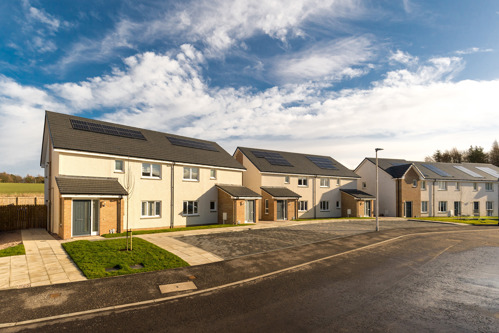
The development comprises 39 energy-efficient affordable homes, housing mix is as follows:
- Eight one-bed cottage flats
- 15 two-bed terrace homes
- 12 three-bed terrace homes
- Two three-bed-semi-detached homes
- One two-bed bungalow
- One three-bed bungalow
Creating a new community and wider area benefits
A commitment to placemaking and accessibility underpins Oakwood Edge. A network of green spaces, a central spine with play provision and a landscaped SUDS basin form the focal points of the neighbourhood, supporting health and wellbeing. Views across the Pentland Hills and Edinburgh skyline are safeguarded, sustaining a strong sense of place and community pride.
Integration with Mayfield’s core path network promotes walking and cycling, including council-requested connections to schools. Woodland planting, native hedgerows, wildflower meadows, bird and bat boxes and ‘hedgehog highways’ actively enhance biodiversity, delivering environmental net gains that benefit residents and the wider area.
Community engagement and partnership working
The project is the result of close collaboration between Lovell, Melville HA and the local community supported by funding from the Scottish government. Consultation shaped the sensitive retention of natural features, improved bus stop facilities and infrastructure upgrades, ensuring benefits were shared with existing residents as well as new.
Social value delivery, tracked at £1.78 million via the Social Value Portal, includes support for the MAEDT Mayfield Garden Project and Y2K Youth Charity, distribution of energy-saving devices, education programmes and a gateway public art installation. Local partners highlight the pride and belonging generated by these measures.
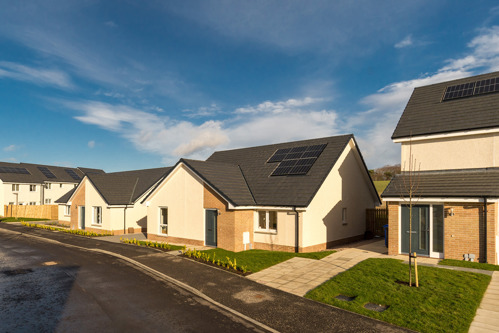
Community engagement at Oakwood Edge was recognised recently, becoming a finalist at the 2025 Scottish Home Awards under the Community Contribution Award category.
Y2K projects manager Lyndsey Ritchie said: “Without the support given to us by Lovell we would not have been in a position to make the improvements which have transformed our facilities.”
- MAEDT manager Sharon Hill added: “Their contributions and support have helped us to keep making a real difference in the community.”
Design quality and location
Oakwood Edge demonstrates exceptional design quality and adaptability. Housing is arranged around open spaces and pedestrian-friendly routes, with attractive frontages and protected distant views of the Pentland Hills. Durable materials align with Scottish government ‘Designing Streets’ guidance, while enhanced palettes at key entrances provide welcoming gateways and reinforce neighbourhood identity.
Working with experienced SAP assessors, Lovell delivered sustainable homes that exceed statutory requirements. Properties achieve an energy performance rating of B and meet Silver Aspects 1 & 2 standards. Each is positioned for solar gain and fitted with water- and energy-efficient fixtures reducing usage by approximately 30 per cent. In addition, solar panels, high-performance insulation and EV charging points ensure long-term sustainability and futureproofing.
The development has also achieved Secured by Design Gold status, further strengthening its credentials for excellence.
- Resident Linda Millar reflected: “We love our new home. It’s bright with the big windows, there’s lots of storage and plenty of space for us. We’re grateful to Lovell and Melville for building a great place to live.”
Innovation in energy and sustainability
Air source heat pumps have been installed in four homes, supported by enhanced insulation, triple glazing and battery storage. These are being monitored against gas-heated homes to compare energy use, comfort and running costs, providing valuable evidence to guide future affordable housing energy strategies across Lovell and Melville portfolios.
Outcomes and achievements
- 39 high-quality, energy-efficient affordable homes completed for Melville Housing Association, including cottage flats, terraced houses, semi-detached homes and bungalows, all for social rent.
- Integrated seamlessly alongside private for-sale housing in a tenure-blind design, ensuring genuine social mix.
- All homes achieve EPC B and Silver Aspects 1 & 2 standards, with orientation for solar gain, water-efficient fixtures (-30 per cent use), solar panels and EV charging points across site.
- Four homes fitted with air source heat pumps, triple glazing and battery storage, monitored against gas-heated homes to assess impact on tenant energy costs and inform future sustainability strategy.
- Sprinkler systems installed in every affordable home, exceeding fire safety standards.
- £1.78 million in social and economic value created, supporting local employment, training and community projects.
- Support for local charities included - MAEDT Mayfield Garden Project – donations, volunteer support, community pantry facilities and Y2K Youth Project – facility upgrades, lighting, storage and safer outdoor areas.
- Educational engagement: construction site safety and careers session for local school pupils.
- Achieved Secured by Design Gold status for safety.
Shortlisted entries
Oberlanders Architects - Tillydrone Affordable Housing
Application entry
- Project name: Tillydrone Affordable Housing
- Lead organisation: Oberlanders Architects
Statement of support
Summary and context
The success of Tillydrone Affordable Housing can be replicated as a model for healthy, sustainable living across the UK, representing a positive shift in the standards of affordable housing undertaken by local authorities and contractors.
An ambitious challenge was set, driven by the client’s vision ‘to create sustainable integrated communities and places by delivering affordable homes designed for life… while supporting the wellbeing and resilience of tenants.’
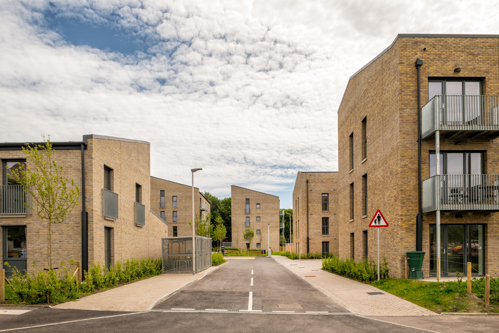
The design team delivered 70 new Scottish Sustainability Gold Standard homes, in a multi-residential development whilst creating adaptable homes for aging occupants which are dementia friendly. The housing, built to Passive House principles, adheres to eight sustainability criteria, meeting rigorous targets. Homes have been developed as economically sustainable both in terms of construction costs and ongoing operational costs for the residents. Using shadow analysis and environmental modelling from the earliest stage in the design process has resulted in a development that responds directly to its environment and addresses not only energy for heating but a more holistic view of sustainability, ensuring an affordable home for the future.
The location
Tillydrone is a designated priority regeneration neighbourhood due to being in a state of disrepair. Maintaining existing properties and community spaces in addition to supporting residents in their ability to meet basic living needs presents significant financial challenges, alongside poor housing quality which impacts residents’ health.
The project, as part of the wider Aberdeen City Council Housing Programme 2022, contributes to addressing a long-term shortage of affordable social rented housing in the city.
The design approach
Key design moves with a focus on operational energy based on Passive House principles ensured low costs. Optimising building orientation and solar gain led to a reduction in insulation and in turn smaller wall cavities and smaller foundations. This allowed the use of high quality double acoustic glazing in lieu of costly triple glazing, with minimal change to occupant’s running costs.
Focus was on the broad range of resident’s needs including reducing water consumption, optimising heating demand and providing flexible, adaptable dwellings with clean filtered air, enhanced noise separation between flats and bedrooms and dedicated outdoor space for all homes. By designing to the Housing for Varying Needs standard, new properties can be adapted with minimal intervention to ensure the comfort and longevity of residents within their homes.
The building orientation creates useable interactive space between buildings, versus the traditional focus on road frontage, designed to foster resident interaction and engagement through playgrounds, raised planting beds and seating arrangements, all while respecting privacy. Prioritised pedestrian-friendly zones push parking to the periphery, providing a tranquil environment conducive to community cohesion.
Community engagement and partnership working
The design was stakeholder led, with meetings held throughout the process including discussions with the local community council where quality of construction, location of buildings, types of external facilities and parking were considered. This included understanding their vision for the site users, focusing on ageing individuals, potentially with dementia, as well as families. On completion of the design stages, review meetings ensured that the design intentions and proposals were understood and agreed in advance of construction.
Meetings with local advocacy groups and current residents discussed property and communal space quality with an emphasis on fostering community cohesion versus isolated pockets of living.
Meetings with the local police force helped to inform critical design decisions leading to a ‘secure by design’ silver rating.
Outcomes and achievements
Tillydrone is a development that challenges the norm for Scottish social housing. The project was one of four sites across the city and was the first completed due to its focus on affordability for both construction and residents. "The architects operated an open book policy when it came to sharing low energy construction knowledge and were instrumental in sharing detailing and specifications with the wider design teams, helping all site teams deliver a well-focused, buildable product while keeping the end occupant at the forefront of all design decisions.” Aberdeen City Council.
70 new homes have contributed to an acute need for affordable and adaptable homes within the city of Aberdeen. Sustainable dwellings promote wellness and sociability, supporting occupants to stay in their homes for longer, all while being cost efficient. Every property uses less than 20 per cent of the energy of a standard building regulation-built home.
The development strategy delivers a unique and distinctive vision for urban social housing. A strategy that can be readily replicated throughout the UK, can relate to varied contexts and creates distinctive and bespoke place making while facilitating sociability and neighbourliness.
Kingdom Housing Association & Campion Homes - Camby Burnside
Application entry
- Project name: Camby Burnside
- Lead organisation: Kingdom Housing Association & Campion Homes
Statement of support
Campion Homes successfully delivered 44 new affordable homes for social rent in the Fife village of Leslie on behalf of Kingdom Housing Association. Camby Burnside, situated near the scenic Lomond Hills Regional Park, is a new community comprising a diverse mix of two, three and four-bedroom family homes, along with 12 amenity standard bungalows designed to support independent accessible living for older residents or those with specific needs.

The placemaking philosophy of "life, then spaces, then buildings," along with the hierarchy of shared public spaces - streets, courtyards, and a central square - established at Polnoon, directly informs the design approach for the Camby Burnside development. This approach promotes a permeable network of public spaces that slows vehicle traffic, while fostering a pedestrian friendly, safe, and attractive environment. This approach, developed by Fraser/Livingstone Architects in collaboration with Horner+Maclennan and Dryburgh Associates ultimately contributes to the creation of a sustainable community of new homes.
The homes are grouped together and accessed via shared courtyard areas, promoting community interaction. The linear layout of the houses in the northeastern corner of each plot allows living spaces to open up to the south and west, providing access to spacious, sun filled gardens. The end gables are positioned along the site boundaries, responding thoughtfully to the edge of settlement context while maximising both visual and physical permeability throughout the development. A new central square is formed at its heart, with links north to expansive open amenity space.
All homes are built to a high sustainability standard and are ‘A’ rated featuring highly insulated envelopes, air source heat pumps, and photovoltaic panels. These measures not only contribute to environmental goals but also help address fuel poverty. Homes comply with Housing for Varying Needs standards and Kingdom Housing Associations detailed design guide, ensuring accessibility, energy efficiency and durability. Low boundary treatments encourage community neighbourliness and maximise natural surveillance, achieving Police Scotland's Secured by Design Gold Status.
The project's ambitious placemaking goals initially presented cost challenges, requiring careful value engineering to stay within budget without compromising quality. Despite early resistance from the local community, the development team prioritised engagement through public consultations. Feedback from residents helped shape the final design and fostered support over time. The result is a development that has been welcomed for enhancing the village and meeting pressing housing needs.
The development offers crucial rental opportunities for residents who may be unable to purchase a home, addressing a wide spectrum of housing needs. At Kingdom Group, we recognise that housing is about much more than the provision of bricks and mortar. We offer a diverse range of services that reflect our mission to provide ‘more than a home’. Our customers are our primary focus and therefore those residing at Camby Burnside can access a host of differing services as part of their tenancy. Our wraparound services are designed to support our customers and their families to reach their potential. These services include tenancy sustainment, energy advice and financial wellbeing resources.
A strong emphasis on community benefits was maintained throughout construction. Training and employment opportunities were created, including apprenticeships and jobs. Site visits were arranged for students from the local school, college learners plus members of Kingdom Works Construction Academy - helping to inspire future careers in the construction industry and connect the development with the wider community.
Overall, the Camby Burnside represents a model for thoughtful, community oriented, and sustainable housing. It not only delivers much needed affordable homes but also contributes positively to the social and environmental fabric of Leslie, increasing footfall to local businesses and strengthening the village's infrastructure.
Outcomes and achievements
- Collaborative and innovative approach to the provision of affordable housing, addressing an identified housing need by providing a diverse mix of house types.
- 50 per cent of allocations made to those registered homeless.
- Achieved Police Scotland’s ‘Secured by Design’ Gold Accreditation.
- Highly energy efficient homes achieving ‘A’ rated Energy Performance Certificated banding (92-100).
- Delivered a variety of community benefits including the creation of jobs and apprenticeships, whilst also contributing to sustained apprenticeships and other community enrichment benefits.
- “Massive thank you to all the team involved with my recent house move. Excellent customer service from start to finish. Absolutely over the moon with how smoothly everything went, updated regularly, thanks again.”
- In addition, our neighbourhoods team have verbally received positive feedback from a number of our customers during their interactions - with one example particularly impactful. This particular customer shared how moving from a private let to an amenity standard bungalow at Camby Burnside has drastically improved their families quality of life. The bungalow offers a more accessible and spacious home, better suiting family members living with disabilities. Furthermore, they now have a spacious and secure garden area where their children can play - which they described as a huge relief.
Ayrshire Housing - Hallrigg Heights - Tarbolton
Application entry
- Project name: Hallrigg Heights - Tarbolton
- Lead organisation: Ayrshire Housing
Statement of support
This project delivered 25 new build homes tailored to cater to the community's specific requirements. Led by Ayrshire Housing and supported by funding from the Scottish government, the affordable homes were part of the wider Hallrigg Heights development by Hayhill Construction.
Hallrigg Heights is a development of 92 homes which comprises of 67 homes for sale and 25 homes for affordable rent. It was important to us that that our homes were integrated with the private homes on the development from an aesthetic/design perspective. Most importantly this integration helps to reduce the stigma often associated with social housing and create a more inclusive environment for our residents. Our aim was to create a sense of community cohesion in this part of Tarbolton to demonstrate the advantages of having a more diverse neighbourhood with people from different income levels who can live side by side and build relationships in this village community.
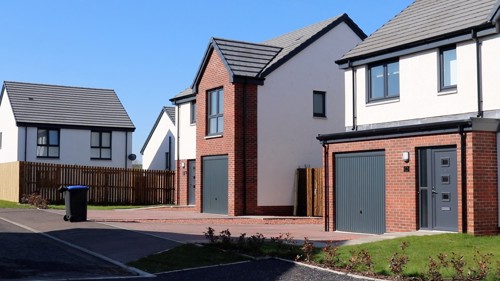
Many of our houses are located in the more rural villages of South Ayrshire and by increasing the supply of affordable housing in a village like Tarbolton we are not only able to increase the customer base for the local business (e.g. hotel and bar, gym, hairdressers) but we increase the housing options available to local people who want to live and work locally.
The affordable homes comprise of a mix of two four-bedroom houses, six three-bedroom houses, 13 two-bedroom houses, one three-bedroom amenity bungalow, two two-bedroom amenity bungalows and one two-bedroom fully wheelchair accessible bungalow. This project delivered much needed affordable housing within the rural community of Tarbolton.
The properties were not only spacious but also energy efficient. Designed around a ‘fabric first’ approach with high levels of insulation and air tightness and supported by Air Source heat pumps the homes have proved to be extremely easy for tenants to heat with very low fuel costs. The properties achieve a high ‘B’ EPC banding. Each property is also future-proofed with a dedicated EV car charger.
As part of their community benefits requirements the contractor made a financial donation to the Tarbolton Christmas lights and also the local county show including raffle prizes. Both of these projects were targeted to bring direct benefits to the Tarbolton area.
As part of the project the contractor also focused heavily on local recruitment with 100 per cent of the site management staff being Ayrshire based. Of the sub-contractors used on site 60 per cent were Ayrshire based and even those based out with Ayrshire employed 80 per cent local staff.
The development was carefully designed to fit in with the rural landscape offering beautiful views over the fields beyond as well as generous outdoor space at the front and back of the properties to allow residents to enjoy the benefits of rural living.
To maintain the village vernacular the development is landscaped throughout with new trees and shrub planting and is designed around two ‘residential greens’. The larger of which contains a children’s play area which brings the private and affordable housing together and creates a community feel within the development.
During the design phase the principals of ‘Designing Streets’ were integrated which led to a development that was calm and welcoming with cul-de-sac streets that allowed for safe spaces for children to play and local neighbours to build community.
Modern and efficient – the homes not only look modern, the build materials and efficiency measures ensure sustainability for the properties
Despite being an edge of town development, the size of Tarbolton means that the properties remain close to amenities and conform to the 20-minute neighbourhood concept. The local primary school and nursery, shops and recreational spaces are all within a 20-minute walk of the development.
Residents enjoy generous outdoor areas with stunning views across the Ayrshire countryside.
Outcomes and achievements
- 25 homes delivered within 52 weeks.
- Received fantastic feedback from residents: “life changing”, “efficient construction method”, “fantastic use of space”, “energy bills have halved”, “site was kept immaculate during build”.
- We held a post development social gathering with all of the residents invited along to enjoy a buffet lunch and have the opportunity to meet their neighbours and forge strong community links.
Link Group - Upper Achintore, Phase 1, Fort William
Application entry
- Project name: Upper Achintore, Phase 1, Fort William
- Lead organisation: Link Group
Statement of support
Upper Achintore’s 82 mixed-tenure homes (74 rent/eight shared equity) boast stunning views across Loch Linnhe and towards Ben Nevis creating an autonomous neighbourhood, with a positive and distinctive sense of place, designed to complement/ensure accessibility to the wider landscape.
The homes reinforce the wider economy of Fort William which suffered from an acute shortage of affordable housing, enabling families/key workers to remain in the community and access housing, boosting community sustainability. A Local Lettings Initiative was developed with a specific focus on these groups and informed the tenure mix to accurately reflect local demand ensuring that local families and workers can remain within the locality - an important contributor in shaping a resilient and socially sustainable community.
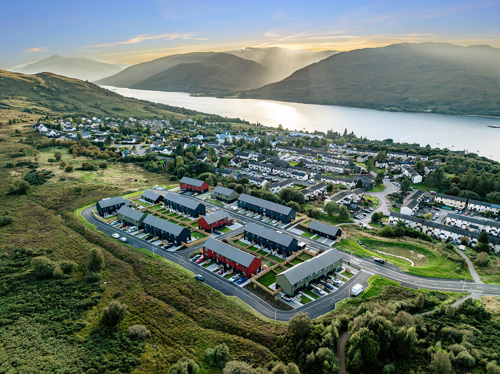
With significant local interest in the development, it was well received as evidenced by the high level of housing applications with the new homes managed by Lochaber Housing Association (LHA) on behalf of Link, which allows for providing day-to-day resident and community support drawing on LHA extensive local knowledge whilst merging Link’s expertise in managing large-scale rural projects.
Collaboration between Link and Highland Council shaped measures to offer wider community benefit, and to help embed the new development in the existing community. This comprised social value activities including:
- Jobs and training initiatives
- Education and curriculum support
- Community engagement and development.
The use of local companies (TSL and Capstone) to carry out most of the construction activities helped make effective use of local supply chains, providing wider benefit to the local economy, as well as drawing on their team’s experience in rural construction projects.
Community engagement and partnership working have been key on this highly sensitive site with the local community and statutory bodies with local knowledge playing a crucial role. Link, in partnership with LHA, were proactive in driving community engagement with critical focus on the impact to the existing community/environment including the establishment of The Upper Achintore Local Consultation Group by Link, meeting on a quarterly and ad hoc basis, to identify, discuss and address local issues. This aligned with Link’s broader objectives of supporting community regeneration through the positive social impact of new, warm, and healthy homes.
Link had ongoing dialogue with Highland Council, regular community consultation events, gave presentations to local elected members and community council to address concerns like traffic management, surface water drainage and ongoing maintenance.
During the build phase existing working relationships were utilised to de-risk the project and plans prepared to mitigate disruption to the local community establishing alternative temporary solutions and keeping the community updated via newsletters, notice boards and social media.
Link offers wide-ranging tenant support services to tenants/wider community including housing advice and income maximisation, also initiatives focussing on employability support and financial assistance. These have proven to have significant long-term benefit on previous sites and have been enhanced with targeted cost of living support through the Link Trust charity.
Using a palette of durable weatherboard cladding complimenting the natural landscape with houses set within mature landscaping and maximising natural internal light the homes incorporate a holistic energy strategy with a fabric-first approach addressing energy demand, as well as introducing features like triple glazing and Air Source Heat Pumps to met sustainable design objectives and achieve high energy efficiency with real benefits to residents.
Workmanship and quality control was monitored by Link’s appointed clerk of works and an independent environmental clerk of works due to the sensitivity of the site and to protect the existing landscape. The site’s challenging topography and unique location required careful planning and collaboration with stringent waste management procedures ensuring that construction waste was either upcycled or reused.
Outcomes and achievements
- 15 key workers/local families, who are essential to sustaining the local community, were offered homes using bespoke Local Lettings Initiative criteria
- 13 apprenticeships and 22 new-entrant jobs created
- Curriculum support through attending local school career fairs
- Donations to local community groups/charities including Lochaber Mens’ Shed of nearly £7,000
- Participation in ‘Help Inside the Hard Hat’ providing on-site information on mental health support resulting in six operatives seeking support
- Achievement of Sustainability Gold Aspect 1
- Reuse of nearly 19,000m3 of excavated peat to restore a redundant local landfill
- Homes have had a positive impact on new residents lives as feedback demonstrates:
- “I also appreciate the layout of the estate, you don't feel as though you are overlooked and the external finishes compliment the local environment.”
- “Our previous home was a drafty, expensive private rental and we were at risk of homelessness as our landlord had served us Notice to Quit. We were lucky to be awarded our home under the Essential Workers Scheme - I work in healthcare - and finding another rental was proving difficult.”
- “We have found the air source heating economically beneficial – not having cold drafty windows ensures the house is warm with sufficient hot water”.
Wheatley Group in partnership with McTaggart Construction - Calton Village
Application entry
- Project name: Calton Village
- Lead organisation: Wheatley Group in partnership with McTaggart Construction
Statement of support
Wheatley Group and McTaggart Construction’s flagship project, Calton Village, represents exceptional achievement in affordable housing delivery.
The project transformed a contaminated brownfield site into a thriving development with 123 homes that exemplifies placemaking, sustainability, and community impact. As the first phase of a 254 homes masterplan, this project strengthens Glasgow's urban fabric while creating social and economic legacy.

Wheatley Group is Scotland’s leading housing, care and property-management group, managing or owning around 96,000 homes and delivering services to over 210,000 people across 19 local authorities in Scotland.
Wheatley was recently named as the UK’s largest builder of social rented homes in the UK. Wheatley delivered more social rent homes than any other housing provider in 2024-25, building 563 homes for social rent in the last year.
Located within Glasgow's key regeneration corridor, Calton Village aligns with the council's Calton area development framework and Calton-Barras action plan. The development connects the city centre with the east end, complementing the adjacent historic Meat Market district redevelopment.
This coherent neighbourhood constitutes important regeneration activity in Gallowgate, demonstrating how thoughtful housing development can support broader urban renewal.
The design evolution from perimeter block to six-storey square block maximises daylight and minimises north-facing apartments. Incorporating a pre-existing diagonal "desire line" into pedestrian and cycle paths acknowledges local usage while enhancing connectivity. Roof terrace communal gardens provide outdoor spaces with views across Glasgow Green and the city centre, while rain gardens manage stormwater, enhance biodiversity, and filter pollutants.
The development achieved 15 per cent carbon emissions abatement through low and zero carbon generating technologies, including district heat networks, enhanced fabric performance, efficient heating systems, and PV panels that sell excess electricity back to the grid for the benefit of residents.
Calton Village delivers to Glasgow's standard, enhancing resident quality of life through physical, functional, social, and environmental value. Modern, spacious homes feature large rooms, open-plan layouts, and wheelchair adaptable homes with increased storage. The 20-minute neighbourhood concept ensures easy access to essential amenities while promoting community connection and reducing car dependency.
Energy efficiency through district heating and high-quality construction minimises running costs, ensuring long-term affordability. Private gardens for ground floor properties, roof terraces, and landscaped courtyards with street furniture create community spaces that support wellbeing and socialisation.
Stakeholder engagement ensured community collaboration throughout design and development. The project demonstrates commitment to circular economy principles through local supply chain prioritisation and surplus material donation to community projects.
Educational engagement exceeded 500 hours with schools and community groups, while a jobs and training programme for long-term unemployed residents created 28 employment opportunities. This generated over £7.5 million in social and economic return, strengthening the local area's social fabric beyond housing provision.
Rigorous quality control measures ensured meeting industry standards and building regulations. The complex remediation strategy for contaminated brownfield land was carefully executed, with railway proximity requiring robust safety measures and traffic management. The project received considerate constructors scheme commendations for workforce wellbeing approaches.
Early contractor appointment enabled collaboration through design workshops, ensuring both aesthetic quality and buildability. The team's expertise in navigating challenges from site remediation to community engagement proved invaluable, while commitment to workforce development included recruiting graduates and apprentices.
Calton Village demonstrates how exceptional partnership between client and contractor can deliver transformational housing that transcends mere accommodation provision. Through innovative design, sustainable technologies, meaningful community engagement, and uncompromising quality standards, this development creates a model for regenerative housing that strengthens communities while addressing Glasgow's housing needs. The project's comprehensive approach to placemaking, environmental responsibility, and social value makes it a worthy recipient of CIH recognition, showcasing the housing sector's potential to drive positive urban transformation
Outcomes and achievements
The development achieved a 15 per cent carbon emissions reduction through innovative low and zero carbon generating technologies, including district heating networks, enhanced fabric performance, and integrated PV panels. The project generated over £7.5 million in social and economic return while creating 28 new jobs through a bespoke training program for long-term unemployed residents.
Community engagement was exemplary, delivering over 500 hours of educational engagement with local schools and implementing comprehensive stakeholder collaboration that incorporated resident feedback into the design process. The development prioritised local supply chains and donated surplus materials to community projects, representing circular economy principles.
Quality standards exceeded industry benchmarks, with six wheelchair-standard homes among the 123 homes, all meeting Glasgow's housing strategy for regeneration, accessibility, and deliverability. The innovative design maximised daylight penetration through a thoughtful six-storey square block arrangement, incorporated rain gardens for sustainable stormwater management, and created unique roof terrace gardens offering panoramic views across Glasgow Green and the city centre, strengthening the vital connection between Glasgow's city centre and the east end.
Wheatley Group in partnership with McTaggart Construction - Beatlie Road, Winchburgh
Application entry
- Project name: Beatlie Road, Winchburgh
- Lead organisation: Wheatley Group in partnership with McTaggart Construction
Statement of support
The Beatlie Road development in Winchburgh represents a model of affordable housing delivery that blends heritage preservation with contemporary living standards. This development of 81 homes, delivered through the partnership between Wheatley Group and McTaggart Construction, demonstrates innovative approaches to community-centred housing design and sustainable development practices.
Wheatley Group is Scotland’s leading housing, care and property-management group, managing or owning around 96,000 homes and delivering services to over 210,000 people across 19 local authorities in Scotland.
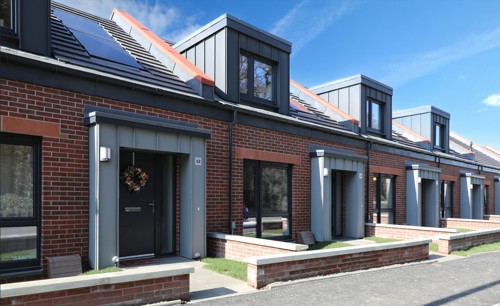
Wheatley was recently named as the UK’s largest builder of social rented homes in the UK. Wheatley delivered more social rent homes than any other housing provider in 2024-25, building 563 homes for social rent in the last year.
The development's core concept of "contemporary miners’ rows" pays homage to Winchburgh's rich industrial heritage while addressing modern housing needs. Drawing inspiration from traditional miners' row cottages that historically fostered strong community bonds, the design reinterprets these heritage properties through a mixed-density approach. The project delivers 29 mid market rent homes and 52 affordable homes, ranging from one-bedroom cottage flats to five-bedroom houses and bungalows.
The architectural language uses a refined material palette of brick, slate, and timber cladding, complemented by traditional details like chimneys and dormers. This creates visual harmony with the surrounding area while maintaining contemporary functionality. Key innovations include adaptable cottage typologies that can evolve from two-bedroom bungalows to four-bedroom homes, and reimagined rear lanes designed as attractive, functional community spaces.
The project successfully navigated significant technical and community challenges. Major infrastructure diversions, including overhead cables and drainage system required extensive coordination with utility providers and neighbouring developments. Environmental considerations were paramount, with stringent ecological protocols ensuring the protection of local wildlife, including newt relocation and comprehensive nesting checks.
Community engagement proved crucial in transforming initial resident committee opposition into support through transparent communication and regular updates. The preservation of a listed wall required meticulous collaboration with ecologists and planners, demonstrating commitment to historical conservation alongside new development.
The development achieves silver standard energy performance, significantly reducing energy costs for tenants while minimising environmental impact. Sustainable construction practices resulted in a remarkable 78 per cent reduction in carbon emissions through low-carbon site cabins and comprehensive energy monitoring. The project achieved an exceptional 97 per cent waste diversion rate with zero waste sent to landfill.
Environmental management extends beyond construction through carefully planned landscaping that encourages local wildlife, supported by detailed ecological statements. Innovative surface water management utilising geo-cellular underground storage minimises flood risks and environmental pollution.
The development prioritises community wellbeing through inclusive design featuring wheelchair-accessible homes and adaptable layouts for multi-generational living. Strategic location within walking distance of essential amenities reduces reliance on private vehicles, while integration with the Winchburgh masterplan provides access to expanding public transport networks and footpaths.
Community benefit initiatives created four job opportunities for West Lothian residents and delivered over 60 hours of STEM and construction career engagement, working with Developing the Young Workforce West Lothian. This involved over 250 students across the region, demonstrating genuine commitment to local development and skills enhancement.
Wheatley Group's comprehensive tenant support framework ensures responsive housing management through proactive communication and robust feedback mechanisms. The design creates inviting public spaces, including a central open area with seating, play facilities, and integrated greenery throughout rear lane boundary walls.
Safety and security measures include well-lit communal areas, clear boundary treatments, and collaboration with local police and community safety organisations. The development facilitates community-building activities and resident-led initiatives, strengthening social connections and fostering genuine belonging.
Outcomes and achievements
The Beatlie Road development achieved exceptional results across multiple performance indicators. The project successfully delivered 81 homes comprising 29 mid market rent homes and 52 affordable homes, ranging from one-bedroom cottage flats to five-bedroom houses and bungalows, addressing diverse housing needs within the community.
Environmental performance exceeded expectations with the development achieving silver standard energy performance, significantly reducing energy costs for tenants. Sustainable construction practices resulted in a remarkable 78 per cent reduction in carbon emissions through low-carbon site cabins and comprehensive energy monitoring. The project demonstrated outstanding environmental management with an exceptional 97 per cent waste diversion rate and zero waste sent to landfill.
Community engagement transformed initial opposition into support through transparent communication, while heritage preservation was successfully balanced with contemporary functionality. The development created tangible community benefits including four job opportunities for West Lothian residents and delivered over 60 hours of STEM and construction career engagement, involving over 250 students across the region.
The project's innovative approach to reimagining traditional miners' rows created a model for heritage-sensitive affordable housing delivery, demonstrating how contemporary design can honour historical context while meeting modern sustainability standards and community needs.
AHR - 1-21 St Cuthberts
Application entry
- Project name: 1-21 St Cuthberts
- Lead organisation: AHR
- Partner organisations: Project Owner / Client – Midlothian Council (novated to Cruden); Contractor - Cruden; M&E Engineer – Hawthorne Boyle; Structural Engineer- Pick Everard; Passivhaus Certifier - Mead Consulting
Statement of support
Playing a crucial role in bringing more affordable assisted living homes to Midlothian, 1–21 St Cuthberts enables its residents to lead safe, healthy and independent lives within the community. Delivered in partnership with Midlothian Council as part of Scotland’s Affordable Housing Supply Programme, the Passivhaus Classic certified development of 20 high-quality flats supports independent living for the community’s most vulnerable residents, while enhancing the wider town centre.
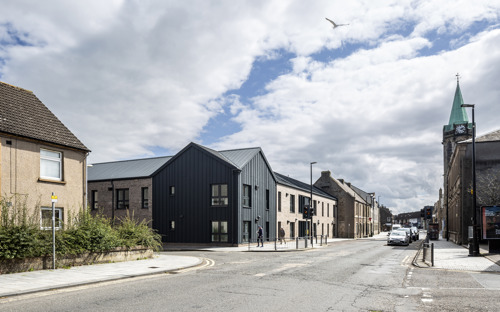
The scheme combines eight assisted living flats for people with learning disabilities and 12 homes for residents over 55. Its core and cluster model ensures tenants enjoys their own self-contained home while benefiting from a supportive, safe and socially connected environment. “From the start, our goal was to not only shape a space that meets the practical needs of residents but to truly enrich their lives — fostering independence, dignity and a sense of belonging for people with learning disabilities in the heart of their community,” reflects Louise Smith, project architect during the design and delivery.
Replacing a long-vacant furniture store, the site has been reimagined as an active focal point on Bonnyrigg High Street. The design continues the existing street frontage, integrating seamlessly with surrounding buildings while introducing a striking corner feature to mark its place in the local landscape.
With shops, healthcare, transport and green spaces all within walking distance, the project supports the 20-minute neighbourhood principle, ensuring residents remain connected to essential amenities and the wider community. Its town centre location also brings economic and social vitality back to the high street, benefitting businesses and reinforcing Bonnyrigg’s role as a hub for surrounding communities.
Close collaboration was central to the project’s success. Midlothian Council worked hand-in-hand with AHR, Cruden Building Scotland and key stakeholders including occupational therapists, disability service providers and representatives of the assisted living and over-55s communities. This ensured the homes reflect the diverse and changing needs of tenants — from spatial layouts to noise reduction measures, adaptable interiors, and provision for telecare and SMART technology. “The people who call these flats home enjoy living in a comfortable, warm, energy-efficient and affordable home,” notes Councillor Stuart McKenzie, Midlothian Council’s cabinet member for housing.
The building’s architecture avoids institutional features, instead presenting as an attractive residential development that blends with its surroundings. Durable brick and vertical cladding give the scheme a contemporary yet contextual appearance. Generous windows provide abundant daylight and accessible entrances, and circulation ensure easy movement throughout. Inside, all homes meet high space standards and feature level-access showers, flexible layouts and thoughtful acoustic design. Ground floor units are fully wheelchair accessible, while upper floors can be adapted for changing mobility needs.
Private gardens and car parking to the rear offer a secure, calm environment away from the high street, enhancing resident comfort and safety.
Part of Midlothian Council’s ambition to achieve Net Zero by 2030, 1–21 St Cuthberts is certified to Passivhaus Classic Standard, ensuring exceptional energy efficiency, airtightness and thermal performance. Mechanical ventilation heat recovery systems maintain fresh air and consistent warmth, reducing heating demand and tackling fuel poverty. “This project truly reflects ‘Homes for Life’ — creating a sustainable, future-proof community that addresses the environmental challenges of tomorrow while enhancing comfort and quality of life for residents,” says Fraser Lynes, managing director of Cruden.
The all-electric development features rooftop solar PV panels, EV charging points, and a brise soleil for summer shading. Residents enjoy warm, healthy homes with dramatically reduced energy bills — up to 90 per cent lower than standard builds.
1–21 St Cuthberts is a benchmark in affordable housing, actively shaping a sustainable, inclusive, vibrant community that supports both residents and the wider Bonnyrigg area.
Outcomes and achievements
Since opening, 1–21 St Cuthberts has delivered measurable social, environmental and economic benefits:
- Improved quality of life: Residents report greater independence, improved wellbeing, and stronger social connections, supported by the core and cluster living model.
- Energy and cost savings: Passivhaus performance has cut heating demand by up to 90 per cent, protecting tenants from fuel poverty and rising energy costs.
- Inclusive design: Homes are adaptable for changing mobility needs, with wheelchair-accessible units, acoustic measures, and provision for telecare/SMART technology.
- Community regeneration: The redevelopment of a long-vacant high street site has created a vibrant focal point, strengthening the 20-minute neighbourhood network and boosting local commerce.
- Partnership excellence: Collaborative working between Midlothian Council, AHR, Cruden and specialist stakeholders ensured a resident-focused design that meets diverse needs.
- Sustainability leadership: As one of Scotland’s Passivhaus Classic certified affordable housing projects, it sets a precedent for meeting net zero targets in socially inclusive ways.
The result is a safe, healthy, future-proof development that goes beyond providing housing — it creates a sustainable community where people of all abilities can live with dignity, comfort and connection.
Osprey Housing - Fair Isle Crescent, Peterhead
Application entry
- Project name: Fair Isle Crescent, Peterhead
- Lead organisation: Osprey Housing
- Partner organisation: CHAP Group
Statement of support
Concluding in May 2025, Osprey Housing were delighted to partner with CHAP Group to deliver 25 new homes for social rent at Fair Isle Crescent in Peterhead, an area of identified housing need. The site developed was an abandoned, long-standing gap site at the centre of a combination of both owner/occupier and Osprey Housing managed socially rented properties.
The project was a negotiated opportunity with CHAP Group and was the first project that Osprey Housing had explored with them. The procurement was done via a negotiated design and build contract, not via the now more typical Section-75 route. This necessitated additional upfront assurance work to confirm that the design met with Osprey’s specification, the needs of our tenants and to allow for CHAP Group to demonstrate their extensive high-quality previous works.
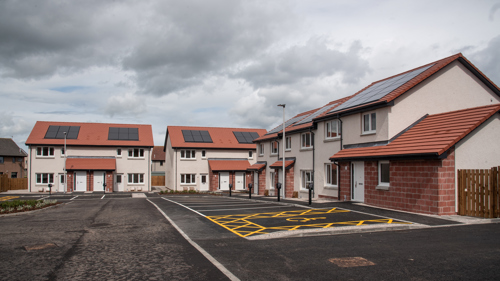
The finalised design proposal for the project utilised every aspect and contour of the restricted site whilst creating a welcoming new neighbourhood at the heart of the established Fair Isle Crescent area. Aberdeenshire Council and the Scottish government both advocated for the design concept and provided the financial support to enable a broad mix of units to be delivered. These comprised of one, two, three and four-bedroom primarily family homes and wheelchair accessible bungalows.
During construction, the project maintained a close working relationship with the neighbouring properties and wider community ensuring that as best possible the works were causing minimal impact. Through various feedback received, it became clear that the community were enthusiastic about the project and keen to see this gap site utilised.
All properties were designed to:
- Form a new community whilst embedding into the adjoining community at Fair Isle Crescent
- Blend in aesthetically with the local established streetscape utilising feature detailing
- Provide layouts that aligned with the modern use of properties and ample storage
- Providing above average parking space with a dedicated electric vehicle charger available for immediate use
The site had a number of challenges including restricted access, ground conditions and constructing in a built-up residential area. Osprey Housing and CHAP Group worked in partnership throughout the build and handover process to ensure that any arising issues were dealt with efficiently. This enabled the project to be delivered eight-weeks ahead of programme and, most importantly, to a high-quality.
Both during the works and following handover, the positive interest in the project has been exceptional. All homes were allocated to a mixture of existing and new Osprey Housing tenants who are all now enjoying their new homes.
The completion of this development also marked a significant key milestone for Osprey — completion of our 500th new build home across the north-east of Scotland in less than nine years.
Outcomes and achievements
This project was appraised by Osprey to meet our strategic aims, align with our growth strategy and meet the needs of tenants and the local community in a sustainable way. Key outcomes:
Demonstrating value for money:
- Project delivered on budget.
- Completed eight-weeks ahead of programme.
Meeting tenants’ needs and priorities:
- Energy efficient homes with low running costs.
- Properties ranging from 1-4 bedrooms meeting a variety of housing needs.
- Wheelchair accessible bungalows.
- Incoming new Osprey tenant feedback - ‘I feel like I’ve won the lottery!’.
Supporting the local economy:
CHAP Group are a local, medium sized enterprise who in turn also use local SME contractors to deliver the works. This ensures that local companies are supported which enables them to take on modern apprenticeships and help secure the future of the construction industry.
Partnership working:
The success of this initial project has resulted in the foundation of a great relationship between Osprey and CHAP who have aligned values, who now seek to work together on further opportunities.
CHAP senior contracts manager Bill Ross, quoted: ”The opportunity to work alongside Osprey Housing has been valued greatly, and the shared commitment to quality and community impact made for a highly positive experience.”
Lochalsh and Skye Housing Association - Darach Court, Glenelg
Application entry
- Project name: Darach Court, Glenelg
- Lead organisation: Lochalsh and Skye Housing Association
Statement of support
The incredibly positive, long-lasting impact of Darach Court on a remote rural Scottish community cannot be underestimated.
The development may only comprise a small number of new homes, but it is a beacon for how social housing can be both anchor and catalyst to a sustainable future.
The lack of affordable homes in the beautiful village of Glenelg in Lochalsh, over nine miles along a single-track road from the A87, has posed in recent years a risk to a fragile local economy and primary school.
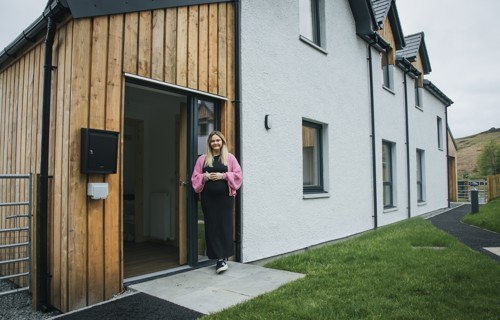
The long-held concept and then reality of Darach (Gaelic for oak) has provided a lifeline; one embraced by the local community - that will act as a springboard for the future construction of more badly-needed affordable homes.
Crucially, it has bound together that community as never before. Glenelg and Arnisdale Development Trust and the Community Council had had for some time “differing views” on what the area needed. Under Darach, they came together to form The Glenelg Housing Committee, on a mission to bring new social homes to the village for the first time in 24 long years.
Their combined commitment was recognised and welcomed by organisations ranging from lead partner Lochalsh and Skye Housing Association (LSHA) to Scottish government, The Highland Council and elected representatives, resulting finally in a clear focus and unstoppable momentum to “get the job done”.
The physical and business challenges faced by remote rural and island communities are well documented. Barriers include everything from land assembly and purchase to the unavailability of contractors, transport and supply of materials.
Team work again provided solutions. The development took shape under McQueen Builders and the consultant team, who created a traditional design, attractive internal layout and superb external accessibility that meets the requirements of young families and older people alike.
The place-making expertise employed takes maximum advantage of the village and mountain views, while the cul-de-sac design promotes sociability and community engagement in which neighbours can look out for children and each other.
The homes deliver Silver level sustainability, featuring everything from EPC B ratings to air source heat pumps and bat boxes.
The development did not come cheap as a result of unavoidable factors, such as the constraints of location and soaring building and transport costs. However, its value to the local economy is unquestionable.
All of the tenants work locally, underpinning the viability of several businesses and enterprises, including the last turntable ferry, local inn and community hall. The future sustainability of the village school is enhanced too by the six Darach children who attend.
The development - subject to no fewer than three separate tender processes - took seven years to be completed, testing to the full the community’s determination and resilience as they overcame barrier after barrier.
The community event held in May to commemorate its launch was met with relief, pride and genuine excitement. Guest of honour, Deputy First Minister and local MSP, Kate Forbes was warmly welcomed by proud new tenants into their homes and marked the occasion by planting oak trees and praising local schoolchildren’s art and poetry exhibitions, which highlighted the community benefits created by the new homes.
The presence and testimonies of each family highlighted the importance and value of outstanding social housing.
The strength of this submission lies in how this project generated incredible community spirit, unity and coherence, delivering a beautiful traditional design and construction and an extremely high standard of finish that takes full account of the Glenelg climate.
One Darach youngster summed it up beautifully: “It’s fantastic to have a cosy, safe, warm home that will give us loving memories.”
Outcomes and achievements
This life-changing project generated unparalleled community focus and unity to meet acute housing need and did so by lead partner LSHA harnessing the support of Scottish government and The Highland Council, as well as the design and construction team and landowner.
Partnership working and resilience over seven years eventually overcame many setbacks and barriers characteristic of those faced by rural highland and island communities.
The development addressed acute housing need through the allocation of the homes to local tenants at the top of the Highland Housing Register, who were previously homeless, overcrowded or living with parents while expecting a first baby.
The accessible homes offer long-term inter-generational living.
Sustainability features include Silver Standard, air source heat pumps, EPC B and bat boxes.
Vernacular sensitivity with traditional timber-framed construction, with block cavity and larch cladding at dormers and porches.
Layout includes porch, drying area, excellent storage and is place-oriented with views of magnificent Glenelg scenery.
Viability of local businesses strengthened, with all tenants working locally.
Six children, with a new arrival expected soon, support the sustainability of the local primary school.
Critical assurance for the future of this remote rural village, with renewed community motivation and momentum to build more homes.



